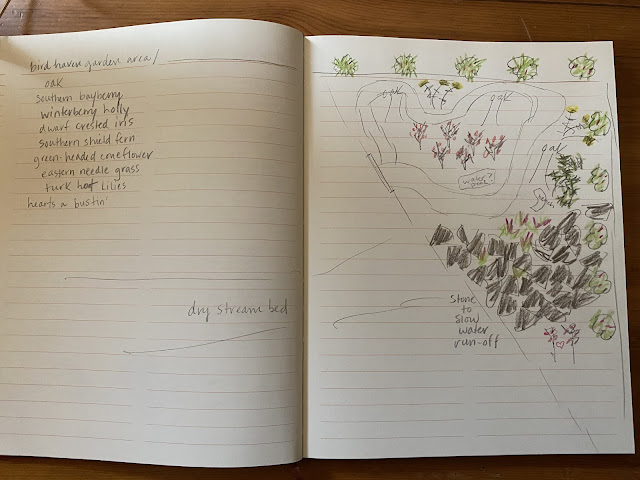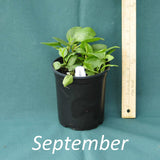The pitcher plants finally have a new home! The yellow pitcher plants and the scarlet belles have given it their best shot where I first put them, and I suppose given that they haven’t died and have bloomed each spring, I can consider my planting them a modest success.
However, they really need a different kind of environment to truly thrive, and they needed more sun than they get once the sweet gum tree leafs out.
It has taken me months to find this container. I wanted a very specific color and shape and when I finally found it online and ordered it, it immediately went on back order. They asked if I would wait until October, and I said yes, but if it couldn’t ship and arrive by mid-month I would cancel the order. Behold, it came very quickly after that and was delivered on a pallet in the back of a huge 18-wheeler that came boldly down our gravel lane. My husband took our truck out and moved it from the back of the big truck into our truck bed. Now we have a new pallet to replace a broken one in the hay stall and the pitcher plants have this new home.
I followed different guidelines from below, mixing 1/2 peat and 1/2 perlite and soaking it down, which took forever. Nor will I be watering with distilled or reverse osmosis water. Now their soil is nicely boggy and all three varieties of pitcher plant are happily moved in. The new ones, Night Sky, are the very large ones you can see in this photo. The other two are small and on the other side. I have room to add a few more in this fall and I may also add something else for added visual interest.
Here’s more info (also from Growing Wild Nursery) about the Night Sky hybrid:
Sarracenia 'Night Sky' is a stunningly beautiful North American pitcher plant that has gained in popularity after it was featured in Nick Romanowski's excellent book, Gardening with Carnivores.
- Vibrant colored leaves
- Produces lots of pitchers, especially in the fall
Details
- 24 to 30 in. tall
- Grows to 12 in. wide over 3 to 5 years
- Clump-forming habit
- Hardy in USDA hardiness zones 7, 8, and 9
Flowering period
In central North Carolina, flowers open in late April before the new pitchers emerge.
How to grow
- Full sun
- Plant in a peat-based growing medium (75% Canadian peat moss to 25% perlite)
- Keep wet by growing plants with their containers sitting in a tray of water
- Don't fertilize, they catch their own
- Only water with rain, distilled, or reverse osmosis water
Care and maintenance
After a hard frost, the tips of the pitchers may turn brown. Trim off the dead parts of the leaf to keep plants looking attractive.
Where to plant
Large tubs and bogs.
When to plant
Scarlet Belle can be planted any time throughout the growing season.
When will my plant flower?
Plants are flowering size and will bloom their first year if purchased before April.
Native habitat and range
The parents of this hybrid grow in bogs and savannas in the southeastern United States.
Source and origin
A hybrid between Sarracenia rubra subspecies gulfensis and Sarracenia leucophylla





.jpg)














